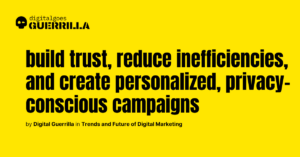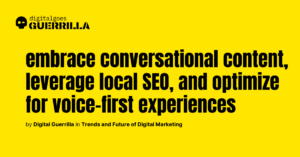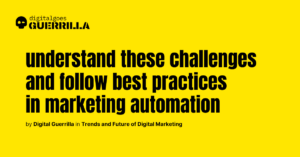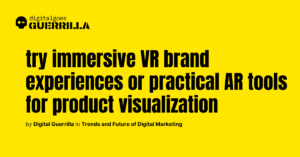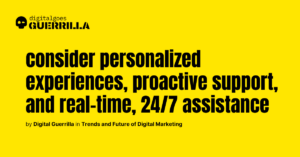In 2024, digital marketing design experienced a series of exciting shifts that will heavily influence the marketing landscape in 2025. From AI-powered creativity to hyper-personalization and immersive experiences, design has evolved beyond aesthetics to become a key driver of marketing strategy. The growing demand for user-centric, data-driven, and accessible design means that businesses must adapt or risk falling behind.
Let’s dive into what happened in 2024 and how these changes will shape digital marketing design in 2025.
AI-Powered Design is Redefining Creativity and Efficiency
In 2024, artificial intelligence (AI) changed the game for digital marketing design. AI-driven design tools like Adobe Firefly, Canva’s Magic Design, and MidJourney helped marketers and designers create stunning, customizable visuals faster than ever before. What used to take hours of manual design could now be done in minutes, freeing up creative teams to focus on higher-level strategy.
These AI tools didn’t just automate design; they allowed for rapid A/B testing of visual content, leading to data-driven decisions on what resonates best with audiences. This resulted in higher conversion rates, more personalized customer journeys, and faster design iterations.
As we move into 2025, expect AI-powered design to be even more integral to marketing. Brands will increasingly rely on AI for content creation at scale, whether it’s generating visuals for social media, crafting dynamic website layouts, or personalizing ad creatives. However, human creativity will remain essential for developing the ideas and creating personalized systems that AI tools cannot execute.
Actionable Insight for Powering Design with AI
If you haven’t already, try AI-driven design platforms to streamline visual content production. These tools will help you quickly produce multiple variations of ads, banners, and social media visuals, enabling you to optimize campaigns with speed and precision.
Read more about What role does content play in a digital marketing strategy?
Immersive Experiences: AR and VR Go Mainstream
In 2024, augmented reality (AR) and virtual reality (VR) solidified their place in the marketing world. Major brands such as IKEA and Sephora used AR to allow customers to visualize products in their real-world environments through their phones. Meanwhile, VR experiences became more accessible, giving customers the ability to “step inside” a product or brand story.
These immersive technologies significantly boosted engagement rates. Social media platforms such as Instagram and Snapchat integrated AR filters and interactive 3D elements, encouraging user participation. In eCommerce, brands offering AR try-on features saw increased conversions and reduced return rates.
In 2025, AR and VR will be even more embedded in digital marketing strategies. Consumers will expect brands to offer immersive product demos, virtual shopping experiences, and interactive ads. Businesses that embrace these technologies will stand out by offering engaging, personalized experiences that build deeper connections with their audiences.
Real-World Example of Implementing Immersive Experiences
Sephora’s AR-based “Virtual Artist” allows users to try on makeup through their app. This feature has improved customer engagement and led to increased online purchases by offering a personalized and interactive experience.
Learn more about personalization in digital marketing starting with the article: Why is personalization important in digital marketing?
Minimalist Design Meets Powerful Data Visualization
Minimalist design, with its focus on clean lines and simplicity, continued to dominate in 2024. But what was different this year was how it blended with complex data-driven content. Brands used minimalist visuals to make sophisticated data digestible for their audiences, creating engaging data stories through sleek infographics, animated graphs, and dashboards.
This trend is particularly important for businesses that deal with large amounts of data, such as those in SaaS, finance, or marketing. Instead of overwhelming users with complex charts and figures, marketers used minimalist design to convey critical insights quickly and clearly.
In 2025, expect this trend to continue as data becomes an even more integral part of marketing strategies. Brands that effectively communicate insights through well-designed data visualization will have a competitive edge, as customers increasingly value data transparency and clarity.
Practical Advice for Minimalist Design and Data Visualization
To implement this strategy, use tools like Tableau or Power BI to create interactive, visually appealing data dashboards. These tools can help you turn raw data into compelling visuals that tell a story, resonating with both internal stakeholders and customers.
Hyper-Personalized Visuals Will Dominate Customer Journeys
In 2024, personalization moved beyond the standard “Hello, [First Name]” emails. Dynamic content—visuals, ads, and website layouts that adapt in real-time based on user behavior—became a major trend. This level of personalization allowed brands to deliver tailored experiences across all touchpoints, increasing customer satisfaction and driving higher engagement.
For example, an online retailer might show a returning customer product recommendations based on their previous browsing history, while a first-time visitor sees a different set of products or offers. Personalized video ads, social media campaigns, and even emails became more visually targeted, leading to higher conversion rates and a deeper connection with the audience.
Heading into 2025, hyper-personalized visuals will continue to be a priority for marketers. Advanced segmentation and dynamic content optimization will allow brands to deliver highly relevant, real-time visual experiences to each customer.
Case Study of Visuals Hyper-Personalization
Netflix’s use of dynamic content personalization is a prime example. The streaming giant uses AI to show different thumbnails for the same movie or show, tailored to what the individual user is likely to click on based on their viewing habits. This tactic has dramatically improved engagement and retention rates.
Don’t stay behind and discover more nuanced aspects of Personalization and Customer Experience in digital marketing
Inclusive and Accessible Design Is Now Non-Negotiable
In 2024, inclusive and accessible design became more than just a trend—it became a necessity. As businesses expanded their digital presence, there was growing pressure to ensure that websites, apps, and digital campaigns were accessible to all users, including those with disabilities.
Brands that made their digital properties compliant with Web Content Accessibility Guidelines (WCAG 2.1) reaped the benefits in terms of improved SEO, better user engagement, and enhanced brand reputation. Furthermore, inclusive design, which reflects cultural diversity, gender representation, and inclusivity, resonated with a broader audience, fostering loyalty and trust.
Looking forward to 2025, accessibility and inclusivity will be even more critical. Brands that overlook these aspects risk alienating potential customers and facing reputational damage.
Practical Advice for Inclusive and Accessible Design
To ensure your website is accessible, use tools like WAVE or Lighthouse to audit your site for accessibility issues. Make sure that text is readable, images have alt text, and interactive elements are keyboard-friendly. Additionally, incorporate diverse imagery and inclusive language in your visual and written content to make all customers feel welcome.
And also check why is mobile optimization important for websites and campaigns?
Strategic Shifts: What These Design Trends Mean for 2025
The design trends we saw in 2024 are not just passing fads—they are reshaping the future of digital marketing. Here’s how they will influence 2025:
- AI-Powered Rapid Testing:
AI will allow marketers to quickly test and optimize different visuals, ensuring the most effective content is delivered to target audiences. Expect more brands to adopt a “test, learn, scale” approach, where design is iterated and improved in real-time. - User Experience (UX) Is the New Design Priority:
As design becomes more functional, marketers must integrate UX best practices into their visual strategies. This will involve creating seamless, conversion-driven customer journeys where design isn’t just about aesthetics but about guiding users to take action. - AR and 3D Content Will Expand on Social Media:
Expect social media platforms to double down on immersive content. Brands that create engaging AR filters or interactive 3D posts will see higher engagement and shares, making immersive experiences a key part of their content strategy.
Final Thoughts: Preparing for 2025
2024 has been a pivotal year in digital marketing design, and its impact will be felt throughout 2025. From AI-powered visuals to immersive AR experiences, these trends aren’t just influencing how marketers design content—they’re shaping the very way brands connect with their audiences.
To stay ahead, marketers need to invest in the right tools, focus on personalization, prioritize inclusivity, and embrace innovation in design. The future of marketing design is dynamic, data-driven, and highly personalized—brands that adapt will thrive.
